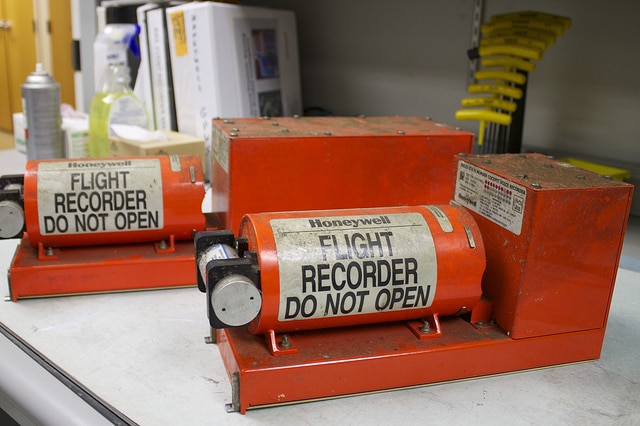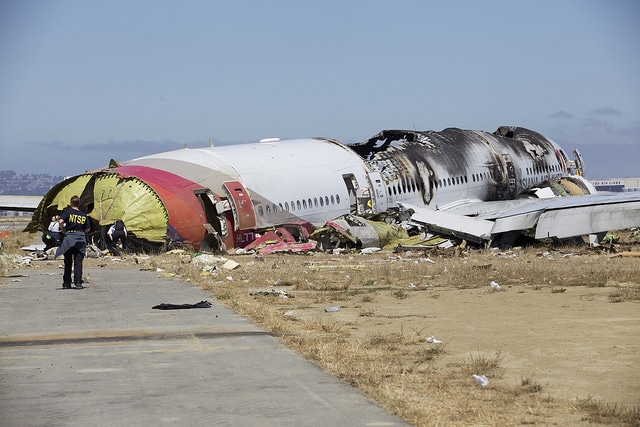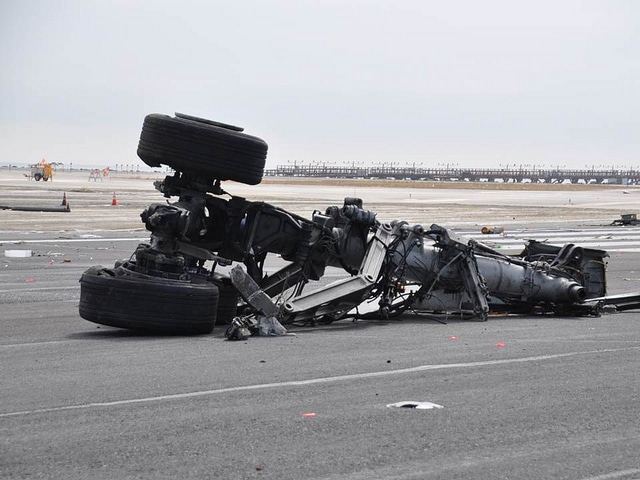Sequence of Events in the Cockpit on Asiana Flight 214
Last week, the NTSB held the Asiana Flight 214 Investigative Hearing.
On the 6th of July 2013, Asiana Flight 214, a scheduled passenger flight from Incheon, South Korea to San Francisco, CA, crashed on final approach after striking the seawall a few hundred feet short of the runway.
The investigation is continuing but a key aspect of the hearing is the sequence of events, as presented by Bill English of the NTSB. His presentation is available on video and I have summarised it below. This explanation of the sequence of events in the cockpit makes it clear how the aircraft ended up much too low and too slow on final approach to San Francisco Airport.
A key issue I’d like to highlight is that the Captain was transitioning from a highly automated Airbus to a Boeing which allows for much more manual control by the pilot. This goes some way to explaining his confusion but does not in any way excuse why no one was watching the airspeed and why the instructor did not take control and initiate a go around much earlier.
Here’s the excerpt from the hearing as broadcast by Bloomberg TV:
The following is not a transcript but my summary of the presentation by Mr English with some clarification of acronyms and technical terms.
The departure from Incheon and the ten-hour flight were routine. The Boeing 777 reached San Francisco area with clear weather and light winds.
The flight crew were vectored for a visual approach to runway 28L as the glideslope portion of the Instrument Landing System was out of service. This had been announced by an FAA Notice to Airman covering the period of the 1st June through 22nd August.
The Pilot Flying was in the left seat. He was a captain transitioning from the Airbus 320 to the Boeing 777. He had 9,700 hours flight time with less than 45 hours in the Boeing 777.
The Pilot Monitoring was in the right seat. He was a newly certified instructor pilot with 12,000 flight hours and 3,200 hours on the Boeing 777.
There were two relief pilots on the flight. One of them was in the cockpit, sitting in the jumpseat.
After reporting the airport in sight, the flight was cleared for a visual approach for a 14-mile straight in final.
Air Traffic Control instructed the crew to maintain 180 knots until five miles out. There was no altitude restriction.
The aircraft passed over the Dumbarton Bridge, descending through 4,800 feet on the extended centre-line of the runway. Indicated airspeed was about 210 knots, decent rate was 1,300 feet per minute. The autopilot was engaged and set to flight level change mode descending to a selected altitude of 1,800 feet. This was the normal Final Approach Fix (FAF) altitude. The autothrottle was engaged in hold mode with the thrust levers at idle.
All of this is an expected configuration for this descent to the Final Approach Fix at five miles out.
Shortly after passing the bridge, the flight crew switched the autopilot to vertical speed mode, with a commanded descent rate of 1,000 feet per minute and the autothrottle was switched to speed mode, with a selected airspeed of 172 knots.
That rate of descent was not fast enough to remain on the normal glidepath. The airplane was now above the normal angle of descent.
The landing gear was extended and the descent rate was briefly selected to 1,500 feet per minute and then back to 1,000 feet per minute.
At this point, the aircraft was about six miles from the runway, flying at about 175 knots, descending through 2,400 feet, well above the glidepath.
The airplane approached the San Mateo Bridge, which is at about the Final Approach Fix point, five miles out. This means that at this point, the aircraft should have been at about 1,800 feet.
The Mode Control Panel (MCP) select altitude was changed to 3,000 feet to prepare for a possible go around, which is a normal action for an approach. This means that if you have to do a go around, the auto-pilot will automatically climb out to 3,000 feet.
Shortly afterwards, the airspeed select was set to 152 knots. The aircraft was still high, well above the desired glidepath.
At an altitude of about 1,600 feet, at about 3.5 miles from the runway, recorded data from the cockpit indicates that the flight level change switch on the Mode Control Panel was activated.
This changes the autopilot and autothrottle operating mode. Flight level change is a autopilot mode normally used for altitude changes during the climbout, cruise and initial descent, but not as a part of the final approach. According to the Boeing Flightcrew Training Manual, it is not recommended for use past the Final Approach Fix.
As a result of this change, the autopilot (AFDS) began to command a pitch up and power increase as it attempted to climb the aircraft to 3,000 feet at 152 knots. That is, the aircraft is at travelling at low speed and now trying to climb to the altitude which had been previously selected on the Mode Control Panel in case of a go-around.
The pilot flying responded by disconnecting the autopilot and manually retarding the throttles to idle. In this configuration, the autopilot was not commanding the airplane, although the system made inputs to the flight directors because it was still in flight level change mode. The flight director computes and displays the proper pitch and bank angles required for the aircraft to follow the glideslope.
As a part of this configuration change, the autothrottle transitioned to hold mode with the thrust levels in the idle position due to the manual override. These modes were sounded on the Flight Mode Annunciator, which is meant to keep the crew informed about the system status.
The autopilot was no longer flying the plane. The throttles were set to idle. The autothrottles were no longer controlling airspeed. Despite this, the airspeed select was changed to 137 knots. This would have had no effect.
About five seconds later, the flight recorder data shows that the left side flight director was switched off, but the right side remained on.
About 1.4 miles from from the runway and at about 500 feet altitude, the Boeing 777 descended through the normal glideslope. It passed through the desired speed of 137 knots and was now rapidly decelerating.
The Precision Approach Path Indicator (PAPI) is a visual display next to the runway which provides vertical guidance for the approach path. In a normal approach, the PAPI would show two whites and two reds. More whites means that the angle of the approach is too high. More reds than white means that the angle of the approach is too low. The PAPI shifted to three reds and one white and then to four reds.
The pitch attitude steadily increased as the pilot pulled back on the column, trying to maintain the correct glidepath as per the PAPI indicators. But with no power, it did nothing but slow the plane down even further.
There was no mention of the decaying speed on the cockpit voice recorder.
The thrust levers remained at idle. The aircraft continued to lose airspeed and sink below the glidepath.
24 seconds from impact, the airplane was .9 miles from the runway and at 300 feet altitude. It continued to descend well below the PAPI glidepath, decelerating through 120 knots and at a pitch attitude of about 7 degrees nose up.
At about 11 seconds before the impact, an audible alert consistent with low airspeed caution sounded through the cockpit.
Three seconds later, with the aircraft just below 100 feet above the water, the throttle levels were (finally) moved forward to full power to initiate a go-around. This was followed four to five seconds later by stick-shaker activation and a verbal call to go-around.
The action was too late and the main gear and underside of the aft fuselage struck the seawall.
The lowest recorded airspeed was recorded at 103 knots which was about 34 knots below the desired airspeed.
Here’s the newly released video of the aircraft at the time of impact:
The tail of the aircraft broke off at the aft pressure bulkhead.
The aircraft slid along the runway before the fuselage lifted into an approximate 30 degree nose-down angle and pivoted 330 degrees, before coming to rest off the left side of the runway.
The NTSB has not identified any anomalies with the aircraft prior to impact. The investigation continues.













Wow that’s a great write-up. I appreciate all the work into this.
Nice writeup. A minor point — it’s the Dumbarton Bridge, not the Dunbarton Bridge.
Oops! Thanks.
Again, all this would seem to point to the fact that airlines are overly relying on automation.
There is nothing against it. In fact, with modern airliners becoming increasingly complex, operating in an ever more busy and demanding environment, automation will allow cockpit crew to concentrate on managing the flight.
But on the downside, basic flying skills are being downgraded. The cost of training pilots to perform in an airline environment is high. Training them on those skills that are not deemed to be essential for operating airliners would add to the cost. In an airline, everything is standardised. Everything is written down in tomes of manuals that prescribe the cockpit crew’s every move, their call-outs and responses. Nearly like a closely choreographed ballet.
In general, this works fine and indeed has been a major factor in making air travel the safest form of transportation in existence.
But in the rare case where pilots elect to operate outside the closely determined set of parameters called “standard operating procedures”, or when an event pushes them out of this comfort zone, a sudden and unanticipated demand on basic flying skills may be too much for the crew. Especially if the developing situation already was putting a high amount of pressure on them, there just may not be enough in reserve to take appropriate and – with hindsight – surprisingly simple and evident action.
During my airline days I was criticized by a line training captain for flying too many ILS approaches by hand. When I replied that I liked to maintain and hone my skills the sarcastic retort was that “maybe I was not up to standard and should be taken off-line to undergo extra simulator training”.
In other words: airlines seem not to be too keen to even allow their pilots to do some extra hand-flying.
But: some of the most spectacular feats of flying skills were performed by pilots who also were experienced flying light aircraft.
Like the Boeing running out of fuel and making a dead-stick landing on a small airport or the A320 landing on the river. Not to forget the 747 that lost power on all four engines after accidentally flying through a volcanic ash cloud and managed to restore sufficient engine power to bring his jumbo jet to a safe landing.
Rudy Jakma,
Airline captain ret.
Although I’m a leisure pilot and former glider pilot, rather than a professional, I find Rudy’s comments all too easy to believe. Automation is all very well, but keeping an eye on all the readings on the equivalent of the “hollow T” is simply basic skills, and is not optional, regardless of how many assist systems are operating. There was no excuse for the Pilot Flying or the Monitor not to be keeping a watch on both airspeed and the PAPI. It is clear from the CVR and FDR information that this was not happening.
Another classic example is AF447. It’s a given that the ASI and related readouts were obviously incorrect. Taking these out of the equation: if you’re heavily pitched up, have full throttle applied, and are still descending, it is highly likely you’re behind the power curve. Both recognising this, and the rectification, are ab-initio student stuff. It appears that reliance on (and, in this case, betrayal by) automated systems overrode basic piloting in the pilots’ minds: without their assistance, and the plane in alternate law, the pilots floundered, didn’t attempt to reconcile conflicting instruments to synthesise a believable set of readings, and killed all aboard in their mutual confusion and conflicting command inputs.
I started on gliders. You don’t climb into a glider, you strap on a pair of wings. Very rapidly, you learn to fly by the seat of your pants. You’re flying the plane at the limits of its – and your – envelope. Rectification of incipient stalls, spins, and launch and control failures becomes ingrained and instinctive. With no automation, and no option to go around, you are completely conscious of all your instruments, and the plane’s state. You have to get every landing right, even in extremely adverse conditions. It made me a hugely better power pilot, and saved my life on at least two occasions.
There’s an argument I’ve heard espoused that all power pilots should have achieved solo glider status at some point, and a certain level of logged glider hours (including an instructor check flight sign-off) per couple of years, to keep those survival pilot skills fresh. When I read reports like OZ214 and AF447, I begin to sympathise with that viewpoint.
Great work and i must say I am quite impressed by the quality of your articles.
I like and subscribe 100 % to Rudy’s comment. Iam personnaly convinced that the more manual flying we do the better. Thing is airlines have a statistical approach of Flight safety and thus encourage pilots (or force them by SOPs ) to use a maximum level of automation. But then they ask to the same pilots to be able to recover the system once it has been completely degraded by a failure or any other reason…and fly like a ww2ace…
This paradox of modern aviation does not work because a very well known law in cyber sciences says that if you want a operator of complex systems to be efficient, you must grant him the possibility to use the system in all the degraded states the system might take…
Thus optimum flight safety will be reach through a compromise ( as always !) between a thorough understanding and use of automation and a Certain degree of freedom given to the pilot to handfly his aircraft just like in the old days to maintain his skills…